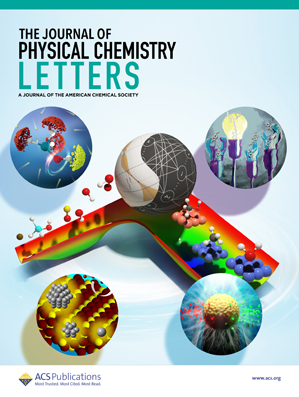Visualizing Intercalation Effects in 2D Materials Using AFM-Based Techniques.
IF 4.8
2区 化学
Q2 CHEMISTRY, PHYSICAL
引用次数: 0
Abstract
Intercalation of two-dimensional materials, particularly transition metal dichalcogenides, is a noninvasive way to modify the electronic, optical, and structural properties of these materials. However, research regarding these atomic-scale phenomena usually relies on using ultrahigh vacuum techniques, which are time-consuming, expensive, and spatially limited. Here we utilize atomic force microscopy (AFM)-based techniques to visualize local structural and electronic changes of the MoS2/graphene/Ir(111) caused by sulfur intercalation. AFM topography reveals structural changes, while phase imaging and mechanical measurements show reduced Young's modulus and adhesion. Kelvin probe force microscopy highlights variations in surface potential and work function, aligning with intercalation signatures, while photoinduced force microscopy detects enhanced optical response in intercalated regions. These results demonstrate the efficacy of AFM-based techniques in mapping intercalation, offering insights into tailoring 2D materials' electronic and optical properties. This work underscores the potential of AFM techniques for advanced material characterization and the development of 2D material applications.利用基于原子力显微镜的技术可视化二维材料的嵌入效果。
嵌入二维材料,特别是过渡金属二硫族化合物,是一种非侵入性的方法来改变这些材料的电子、光学和结构特性。然而,关于这些原子尺度现象的研究通常依赖于使用超高真空技术,这些技术耗时,昂贵且空间有限。在这里,我们利用基于原子力显微镜(AFM)的技术来可视化硫嵌入引起的MoS2/石墨烯/Ir(111)的局部结构和电子变化。AFM形貌显示结构变化,而相位成像和力学测量显示杨氏模量和粘附力降低。开尔文探针力显微镜强调表面电位和功函数的变化,与插层特征对齐,而光诱导力显微镜检测插层区域增强的光学响应。这些结果证明了基于afm的技术在映射插入中的有效性,为定制二维材料的电子和光学特性提供了见解。这项工作强调了AFM技术在先进材料表征和二维材料应用开发方面的潜力。
本文章由计算机程序翻译,如有差异,请以英文原文为准。
求助全文
约1分钟内获得全文
求助全文
来源期刊

The Journal of Physical Chemistry Letters
CHEMISTRY, PHYSICAL-NANOSCIENCE & NANOTECHNOLOGY
CiteScore
9.60
自引率
7.00%
发文量
1519
审稿时长
1.6 months
期刊介绍:
The Journal of Physical Chemistry (JPC) Letters is devoted to reporting new and original experimental and theoretical basic research of interest to physical chemists, biophysical chemists, chemical physicists, physicists, material scientists, and engineers. An important criterion for acceptance is that the paper reports a significant scientific advance and/or physical insight such that rapid publication is essential. Two issues of JPC Letters are published each month.
 求助内容:
求助内容: 应助结果提醒方式:
应助结果提醒方式:


